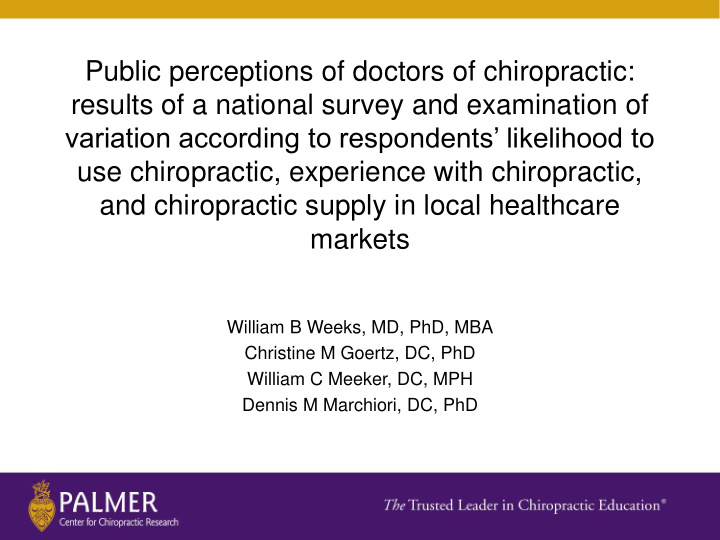



Public perceptions of doctors of chiropractic: results of a national survey and examination of variation according to respondents’ likelihood to use chiropractic, experience with chiropractic, and chiropractic supply in local healthcare markets William B Weeks, MD, PhD, MBA Christine M Goertz, DC, PhD William C Meeker, DC, MPH Dennis M Marchiori, DC, PhD
Objectives To determine whether • Perceptions of doctors of chiropractic (DCs) varied according to likeliness to use chiropractic care, • Particular demographic characteristics were associated with chiropractic care use, and • Perceptions of DCs varied according to the per- capita supply of DCs in local healthcare markets
Methods We analyzed results from a 26-item nationally representative survey of 5,422 members of The Gallup Panel that was conducted in the spring of 2015 (response rate = 29%) that sought to elicit the perceptions and use of DCs by US adults.
Comparison groups We compared survey responses across • Respondents who had different likelihoods to use DCs for treatment of neck or back pain, and • Respondents who had different experiences using DCs
Table1. Comparison groups
Patients who used DCs were • More likely to be – Female – White – Older – Employed full time
Expected users were more likely to perceive that DCs are effective at treating neck and back pain…. (p<0.001) The dotted horizontal line indicates the overall proportion of respondents who agreed or strongly agreed to the question.
…and more likely to perceive that DCs are trustworthy (p<0.001). The dotted horizontal line indicates the overall proportion of respondents who agreed or strongly agreed to the question.
Expected users were less likely to perceive chiropractic care as dangerous…. (p<0.001) The dotted horizontal line indicates the overall proportion of respondents who agreed or strongly agreed to the question.
….but more likely to perceive that chiropractic care is expensive(p<0.001). The dotted horizontal line indicates the overall proportion of respondents who agreed or strongly agreed to the question.
We also found • That patients who had used DCs tended to want to use them for treatment of back or neck pain as opposed to for general healthcare issues • That a higher per-capita supply of DCs was associated with higher utilization rates and a more favorable regard for DCs.
Summary • Our analysis of a national sample of US adults found that 14.0% of US adults have used chiropractic care in the prior 12 months. • The study found that 61.4% of US adults believed that chiropractic care was effective at treating neck and back pain. • Among survey respondents, 52.6% thought doctors of chiropractic (DCs) were trustworthy, while 24.2% perceived chiropractic care as being dangerous. • As respondents’ likelihood to use a DC increased, perceptions of effectiveness and trustworthiness increased, and perceptions of danger decreased. • A higher per-capita supply of DCs in the local healthcare market was associated with a higher utilization rate and more positive perception of DCs.
For more information Read the paper Read the report (www.palmer.edu/gallup-report) Contact Dr. Weeks at wbw@dartmouth.edu
Recommend
More recommend